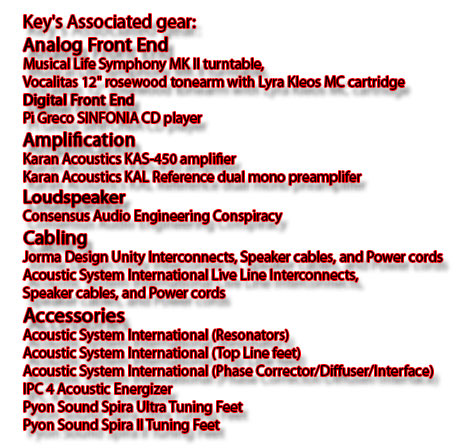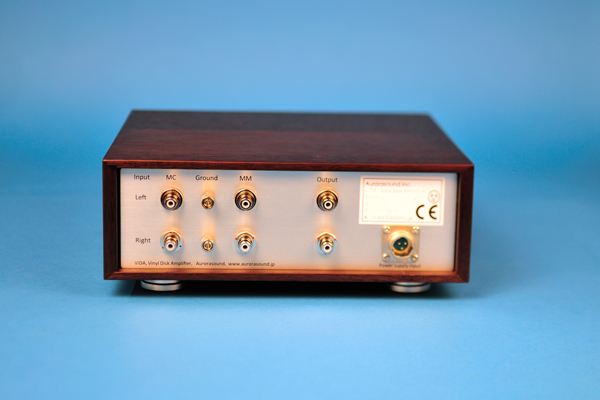Aurorasound VIDA Phono Stage


Wow, how fast time flies! It has already been four years since I embarked on the road to the analog world. One of the best things I have ever done was to reward myself with a turntable on my 50th birthday. I enjoy listening to digital for its sound quality and convenience, but there’s something special about analog as it sounds just right and it puts me closer to the music in a unique sort of way. Don’t get me wrong, digital has come a long way and when its done properly it’s very close to analog. I know it’s a matter of preference but analog touches me more deeply and moves my soul. Of-course the recording quality matters just as much in digital as in analog to sound their best. Most of my listening was done using my reference Musical Life Symphony turntable and the Musical Life Vocalista 12” tonearm, and Lyra Kleos moving coil cartridge with a Karan Acoustics KAL Reference dual mono preamplifier with built-in phono-stage. My reference system has evolved and improved a couple of notches and, thanks to Rumen Artaski from Thrax Audio, I’m really enjoying my Thrax Dionysos preamplifier and the new Thrax Teres Mono amplifiers immensely. I just upgraded to them recently as my new reference electronics. The system is connected with incredible sounding Enklein David interconnects, speaker cables, and power cords (stay tuned for a full review). Also, as you would imagine, my vinyl collection has gotten a little bigger since I acquired my Musical Life Symphony turntable.

Additionally, I wanted to find a phono-stage that didn’t cost an arm and a leg and still sounds great. Actually, I knew only one person who had a product that would suite my requirements and that is Alfred Kainz of Highend-Electronics, who incidentally also serves as the distributor of the Aurorasound from Japan. I had heard very positive comments in regards to Aurorasound’s VIDA (Vinyl Disk Amplifier) from my colleagues and audiophile buddies. I hadn’t spoken to Kainz in a while and it seemed a good time to call him and say hello and see about reviewing the VIDA. I asked Kainz about the VIDA and he was very enthusiastic about me reviewing the product. He told me he would send me the VIDA with a balanced output in about three weeks. I was informed by Kainz that he offers a home trial of the VIDA and he’s having great success and he’s very confident in it. I was very excited to see how the VIDA would perform with my new system.
Aurorasound is from Yokohama Japan, a company founded by Shinobu Karaki five years ago. Karaki san has 28 years experience working for Texas Instruments, Japan. He is a passionate musician, a guitar player, a music teacher, and has been an audiophile for many years. His love for music, his trained ear and extensive know-how in electronics and integrated circuits makes Karaki san an ideal person to design high-end audio. The Aurorasound VIDA (Vinly Disk Amplifier) uses a state of the art semiconductor technology, a LCR-type RIAA network phono- stage amplifier with a precision DC circuit ; uniquely it utilizes the latest semiconductor devices and a discrete amplifier circuit to achieve a complete DC circuit design, and, brilliantly, capacitors in the signal path were completely eliminated. It enables a completely flat frequency response without any coloration across the audible range. The active circuit DC servo circuit permits absolutely stable outputs regardless of fluctuations in the inputs and operating temperature. Aurorasound states that “the resolution and distortion in low frequency are improved significantly; therefore, you will be able to even sense and feel the atmosphere of the music hall, performers and the staging.” The VIDA uses a toroidal transformer for its power supply and a Schottky barrier diode which allows ultra-low noise. Brilliantly, it uses a separate high-speed semiconductor-based stable power supply circuit to eliminate any leakage flux noise completely. Unlike conventional NF and CR type, VIDA implemented an ideal circuit design with a constant impedance LCR type RIAA circuit. As a result, across the entire frequency range, the RIAA curve correction is achieved without fluctuation. In the past and currently, vacuum tubes were used with a large chassis; however, VIDA managed to use a compact size thanks to its latest semiconductor technologies. Cleverly each component is placed according to the signal flow in a symmetrical circuit and in the shortest route. The equalizer circuit utilized the renowned Swedish Lundahl filter-coil, which is widely used in professional equipment.
VIDA’s main task is to ensure the small signals recorded on the vinyl disk are precisely restored to a flat response using an(L) coil and CR network circuit, which goes through the RIAA curve having attenuated the lows and boosted the highs. At the same time, it must accurately amplify the signal by roughly 1,600 times (MC). VIDA manages to achieve very high S/N ratio with a careful selection of the components, circuit design and PC board arrangement.

The VIDA arrived in a medium sized boxed carton. Both the control unit and the separate power supply were securely packed. The VIDA’s construction quality is of a very high standard, and the chassis and controls are well laid out. Its retro late 60s styling is simple and elegant. It features superior fit and finish of machined aluminum and a fine wood veneer. The separate power supply is compact and robust and also finished in aluminum. The VIDA’s front panel is well thought out; there’s a nice big square mute button on the top left, and below to the right, there are five toggle switches; a cartridge demagnetizer switch; a stereo or mono switch; a direct or subsonic switch; an MC or MM switch; and a High or Low impedance switch. On the back of the VIDA there are two high quality rhodium RCA inputs for MC and MM and each has a ground and one set of RCA outputs and one XLR output (optional); on the bottom right is the power supply input cable to be connected to the power supply. I left my VIDA on all the time by turning on the switch on for the power supply.
Kainz informed me that the VIDA required about 100 hours of burn-in for optimum sound. That’s a long wait. I normally burn-in for at least couple of weeks before doing any serious listening but I didn’t have the patience, so I started to listen to it right way and boy it sounded good, but not quite great. That came a little later. I have to admit I was very impressed. I could tell immediately the VIDA’s noise floor was very low, allowing the music to emerge infused with very detailed information.
I let it burn-in for about a month or so and I started to listen. Wow! Practically anything I put on it sounded glowing. The sonic aspect impressed me when I put the VIDA in my system in place of my reference Karan Acoustic mono reference preamplifier because of its quietness; it was a touch quieter with a blacker background. It was dead quiet. This moderately priced (relatively speaking) phono stage preamplifier conveyed music brilliantly, with artifact-free sound that was very striking at any price. I put on a beautiful recording of Beethoven’s Piano Concerto N0.2 in B flat major op.19 performed by Wilhelm Kempff and Ferdinand Leitner conducting Berliner Philharmoniker (DG 138775). The instrumental textures were free of grit, grain and glare while overall timbre was involving and intimate. Notes seemed to flow out effortlessly – both piano and fully orchestrated passages displayed a touch more color and added dimensionality. Kempff’s rendition of the piano was captivating; listening to the Adagio was more involving, using the sustained pedal, space between the notes in the still air was more palpable. The VIDA created precisely portrayed spatial cues and rendered a deeply layered and holographic three-dimensional soundstage that was a top notch. To me, listening to classical music on vinyl produces a more realistic sound than a CD; it renders music in such way that it’s a touch more organic; the sense of space around each instrument became tangible, and the soundstage became three-dimensional, and gave me a sense of more vividness as if I were listening to a live venue.
Bass performance was excellent with very deep extension, definition, and control. Pitch in the lowest octaves was accurately defined and to my delight the VIDA was able to delineate the contrabass pizzicatos and bass guitar snaps brilliantly with outstanding speed, pace and drive. However, when I switched back to my Karan, it produced a touch more solidity, weight, and a fuller bass, though I noticed the difference only in direct comparisons. The VIDA’s top end was clean, fast without being bright or edgy, and the detailed top end contributed to a sense of spaciousness and air.
The VIDA’s ability to illuminate timbre and detail was excellent. While rich and full, instrumental textures were not too ripe or romanticized. Attacks were fast and sharp, yet lively. Equally the midrange was impressive. The human and instrumental voices were reproduced naturally in a well- balanced texture, body, and tone. The voices were wonderfully rendered with revealing detail and nuance, providing for an extremely organic and involving presentation. I put on one of my favorites, the Bill Evans Trio’s Sunday at the Village Vanguard (Riverside RPL 9376), which was recorded live at the Village vanguard in 1961. I must have listened to this masterpiece album in both vinyl and CD countless times. Amazingly this recording is over fifty years old and it sounds outstanding in both mediums, vinyl and CD. But I preferred the vinyl over the digital; it conveyed the music more naturally and the music flowed effortlessly throughout all the frequencies. “Alice In Wonderland” was rendered superbly with emotion and life. The realism was amazing and the ambience retrieval was extraordinary; I could hear many subtle nuances. The Trio was in perfect harmony; it was outstanding and it drew me into the music. Bill Evans’ piano was rendered stunningly and had a wonderful richness with nice harmonics. The cymbal work of Paul Motian was delicate, sweet and detailed and vivid. Scott LaFaro on bass was articulate, warm with power and his virtuosity was exceptional.
The Aurorasound VIDA represents an outstanding accomplishment at its price point. The VIDA’s overall presentation was free of grain and edge, with stark quietness. I really enjoyed my vinyl collection immensely with the VIDA; its black background is what sets the stage for its remarkable resolution, openness, and harmonic integrity. It produced musical excitement with all types of musical genres. In the end, nothing but sonic pleasure. The Aurorasound VIDA is my Stereo Times “Most Wanted Component” award winner. Highly recommended!


Key kim
Specifications:
Input: 1x MM Gain 39dB 47kOhm, 1x MC Gain 64dB (comp: High 10-100Ohm, Low 0.6-10Ohm)
Optional 2x MC (+$250)
Optional rotary switch for 6 add. impedances for MC cartridge (+$1000)
Output: Line Level, unbalanced RCA, optional XLR balanced (+$1000)
RIAA Deviation:10Hz – 20kHz +/- 0.25dB
THD+N: 0.025% – MC – A-Weighted
Input Noise: -138dBV MC
Dimension: 60mm x D250mm x H100mm 3kg (Main Unit)
W114mm x D200mm x H70mm 1.4kg (Power Supply Unit)
Power Supply: AC 100V-120V 50-60Hz, Max 40W
Price $4,990
Highend-electronics, Inc.
Alfred Kainz
19593 Roanoke Road
Apple Valley, CA 92307
Phone: 760-490-2410
Fax: 760-242-1065
eMail: office@highend-electronics.com
PayPal: paypal@highend-electronics.com
Stereo Times Masthead
Publisher/Founder
Clement Perry
Editor
Dave Thomas
Senior Editors
Frank Alles, Mike Girardi, Russell Lichter, Terry London, Moreno Mitchell, Paul Szabady, Bill Wells, Mike Wright, and Stephen Yan,
Current Contributors
David Abramson, Tim Barrall, Dave Allison, Ron Cook, Lewis Dardick, John Hoffman, Dan Secula, Don Shaulis, Greg Simmons, Eric Teh, Greg Voth, Richard Willie, Ed Van Winkle, Rob Dockery, Richard Doron, and Daveed Turek
Site Management Clement Perry
Ad Designer: Martin Perry






Be the first to comment on: Aurorasound VIDA Phono Stage